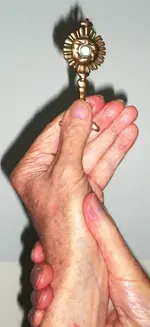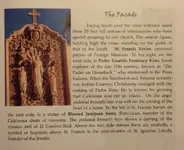Hola amigos,
Springfield wrote
Considering that our debate more closely resembles a courtroom battle, this would be the normal and correct approach, for each side of the debate (guilty vs innocent) to present the case for their respective sides, and against their opponent's. It is not a scientific exam of a new species of amoeba, though our discussion often delves into minutea.
Springfield also wrote
I must respectfully disagree - the Catholic study of the Wealth of the Jesuits in Mexico 1767, conclusively proves the Order owned and operated MINES. That is a key prerequisite to establish that the product of said mines, precious metals, would and must exist, yet such prodcuts have very largely never been accounted for. Considering that the Jesuit apologist position in modern times has denied ANY and ALL mining activities, having used the Indians as slaves, of ever having accumulated treasures, all of which positions are provably false, and contradicted by older reference sources, any prudent man must see that the Jesuits indeed owned precious metal mines and operated them, some openly and legally and yet very quietly. When their mining activities were brought to light, by other Catholic religious authorities, the Order violently opposed that authority (Palafox). More on this in a moment.
Springfield also wrote
Joe's former or current view on the topic really have no bearing on the question. His former view appears to have been focused on Jesuit treasure in the Superstitions, for which there is virtually no evidence to support, at least not that I am aware of. A man of reason always holds his opinions open to revision when new evidence appears. I do not know the generation of Joe's view, however it would be very easy to go from believing the treasure stories in circulation, to total disbelief by then reading such authorities as Polzer and Bolton, especially since the whole subject of whether the Jesuits had mines and treasures has not been a topic of interest to non-partisan historians. This progression of opinion would be logical also by a look at the Peralta stones, which so many believe to be Jesuit, and yet there is nothing to tie them to the Jesuits specifically other than quasi-Catholic symbols and a leap of logic. I too have had a complete change of view on this topic, for I once thought ALL lost treasures/mines were so much fantasy.
As an aside here but to address the prudent man question, there should not be any evidence that the Jesuits had mines, nor were wealthy, if we are to believe they did not have mines nor wealth. Yet we have a record of mines owned openly, Polzer admits to priests caught mining, West found a similar case in which the mines were claimed to be owned by the college of Matape, the Pious Fund for California owned mines, the college of Queretaro's main source of income and support were the mines owned by the college. All these mines were owned openly, yet our Jesuit apologists and many historians are silent about them! Are we to believe Polzer then or Bolton, both of whom held that the Jesuits never had any mines?
Further, we have legends of lost mines which, according to the Indians whom passed the stories to earlier treasure hunters, were worked by the padres using the Indians as labor, and which were deliberately hidden on their departure. Some of these legendary mines have been found, and you can stand in them, like the Salero. These illicit, secret mines were NOT owned openly, nor are they often admitted to though Nentvig mentions several like the mines of Arivaca and near Guevavi. The fact that you have legends of lost mines, which were found and you can stand in, should be very convincing evidence that other "legends" of lost mines which have not yet been found, are true.
Cactusjumper wrote
I put that statement in BOLD typeface to emphasize the direct evidence that our Jesuit padres did practice secrecy in their communications. There are several similar, if briefer statements in Segesser's letters, for he knew that his mail was being opened and read by others. So I must respectfully disagree, that this
proof of the practice of keeping communications secret, which extends beyond just mining, is evidence that the Jesuit records must be viewed with a suspicious eye.
Cactusjumper wrote
Then you will remain locked in your position forever, for it is extremely unlikely that any Jesuit authority is ever going to admit "guilt" by positively identifying any treasure recovered, nor is it likely that any one who finds such a treasure, is going to send it off to some academics to study. That does not speak well of you amigo, to insist on a nearly impossible type of evidence before you would re-consider your position.
Frankly I do not understand this immovable position held by you, and some others here (including a few whom do not post but we have communicated by PM) which seems to demand even more than what already exists. We have turned up documentation of Jesuit owned and operated precious metal mines, we have cases of once-legendary lost mines which have been found and you can stand in, we have some impressive treasures witnessed by more than one authority as at San Xavier del Bac, which has vanished into the air, we have cases of the Jesuits themselves reporting that they hid the "ornaments of the church" during times of crisis, we have the Spanish authorities efforts to turn up the wealth they knew the Jesuits had accumulated which were largely a failure (and little wonder that the Jesuits witnessing the rather inept search methods, were laughing up their sleeves) we now even have a Jesuit complaining that he cannot work the silver and gold mines in safety, making it hard to come up with money!
This post is already very long but I have to add this.
As mentioned above, bishop Palafox found a state of affairs in Mexico that shocked him so badly that he was compelled to write to the Pope about it. Does he complain about the Jesuits having girlfriends or other shocking abuse of their position? NO - in fact here is that letter (again) as I am too lazy to go hunt up the old post where it was, and to save our readers whom have not read it from the same.
The rich silver mines are but ONE aspect of the massive wealth being accumulated by the Jesuits, and remember this letter to Pope Innocent XI was written in the mid-1600s, the Jesuits remained operating and accumulating wealth in Mexico for another century!
This massive wealth Palafox saw as a threat to the very existence of Mexico, which indeed it was! The English visited Jesuit Baja California and published the massive wealth seen there. Yet even though it was known that the Jesuits were indeed massively wealthy, very little of that wealth was found by the Spanish authorities, as indeed very few of their mines were found! A simile would be if you saw me holding a bucket of gold, know for a fact that I then passed away without having sold, spent or given it away nor of traveling, you would know that bucket of gold exists and is hidden.
We are hampered by not being the first treasure hunters to investigate this matter, for the earlier fellows had access to any and all documents that were still held by the various Jesuit missions and visitas. These fellows removed what ever they wished. By at least one account, they found documentary evidence of over 200 Jesuit mines in what is today Arizona, though we have not one document of that evidence. These mines are not mentioned by the Jesuit apologists nor historians, (other than Nentvig's passing mention) though even father Segesser stated that he was in the silver mountains, where there was as much lead as silver, that he could not work the gold and silver mines do to the dangers from hostile Indians. Does father Polzer admit that San Xavier del Bac mission owned mines? Hardly! Yet father Kino himself was shown a piece of pretty green horn silver on his very first visit there, which came from the mine which later became known as la Esmerelda for the pretty green ore. Those mines of which the early treasure hunters claimed to have found documentation of, were not giant Anaconda type mines by the way, which point I would not raise except that some people are so black and white, all or nothing in their views; yet though these mines are almost certainly small by modern American standards, they are certainly more than prospects, and are exactly the sort of mines which would be suitable for the typical Mom-n-Pop small modern operation to exploit.
Cactusjumper also wrote
Thanks for the suggestion, however it is not "
The" point that makes or breaks the case for me. Chisels or crowbars are both useful MINING TOOLS. If it is of tantamount importance to you, then by all means please do pursue it. However the other statements in Segesser's letters, including his complaint about not being able to work the gold and silver mines so money is hard earned, I would think to be a far more weighty piece of evidence. Word games will not absolve the Jesuits amigo.
Also, I do not think those "Kino" bars are solid proof of Jesuit mining. Especially not when you can literally stand in mines they operated in Arizona and Sonora. The bars look to be pious frauds to me, however were I to find a stash of several thousand of such bars, I would not turn my nose up at them either! But considering that the king of Spain had ordered ALL religious orders to stop mining, and the mining did not stop, plus the Jesuit general had repeatedly ordered his missionaries not to be involved in commerce while they proceeded to do so very energetically, it would be rather odd to put Kino or any other Jesuit name directly on precious metal bars which would be evidence of criminal activity. Besides, the mines belong to the various mission churches and colleges, not to individual Jesuits in most cases.
One last thing here (to Joe) but the fact that a person "likes" a post of my own, has little bearing on anything. I often click on the "like" for a post that is well done, or well written, even if I completely disagree with the proposition it states. I am pretty sure that many others do the same. I do not know the proposition Deducer is attempting to prove, nor am I trying to support or disprove his statements and/or evidence. Your rather offensive statement however Joe, is a surprise and hardly conducive to constructive debate.
Good luck and good hunting amigos, I hope you find the treasures that you seek.
Oroblanco












